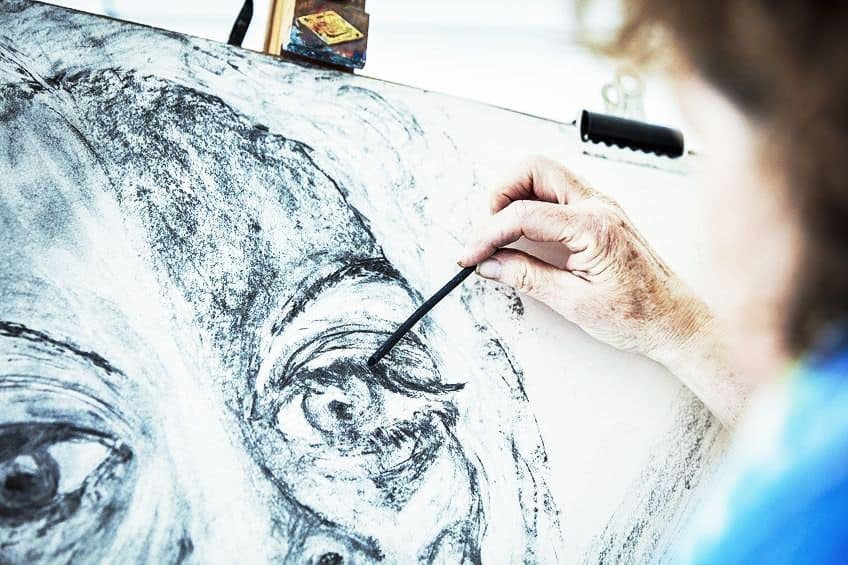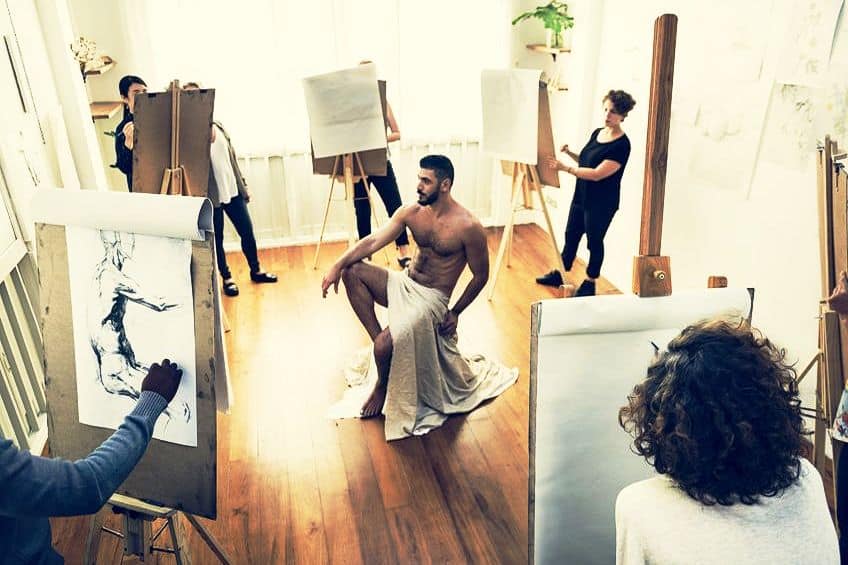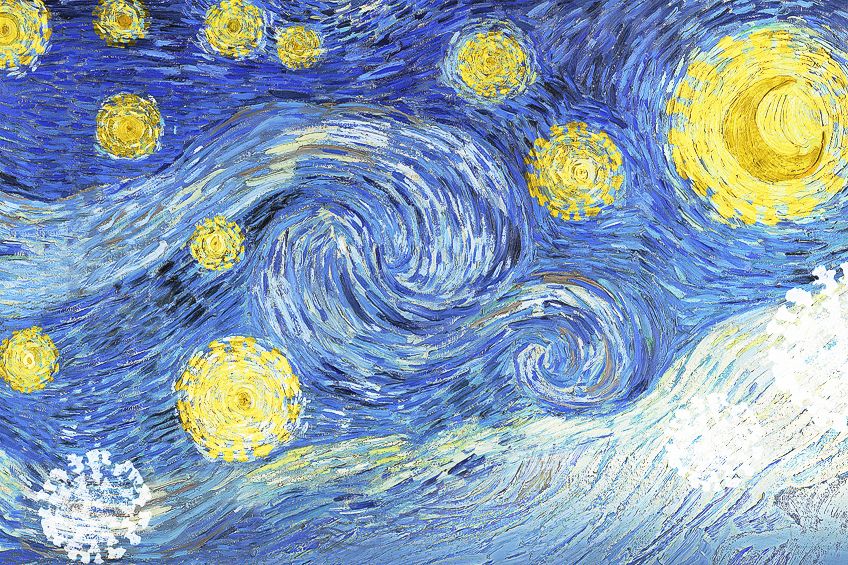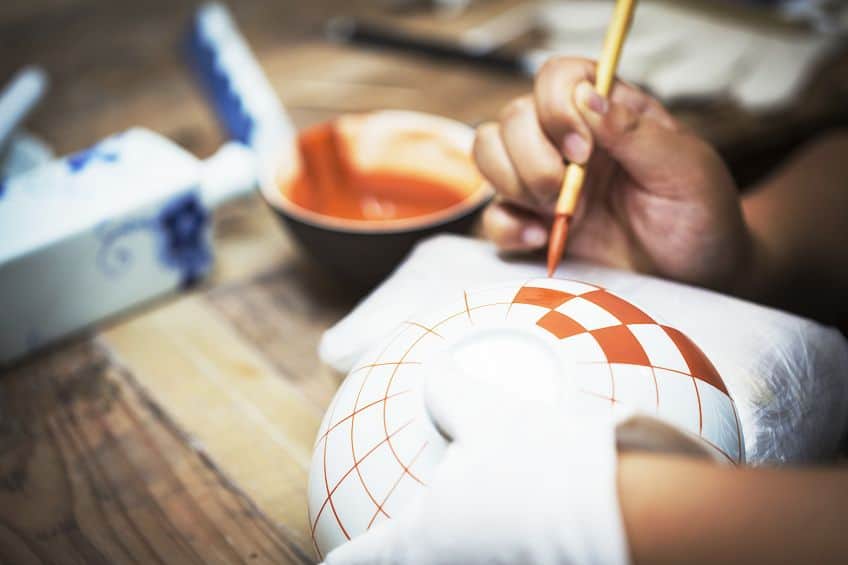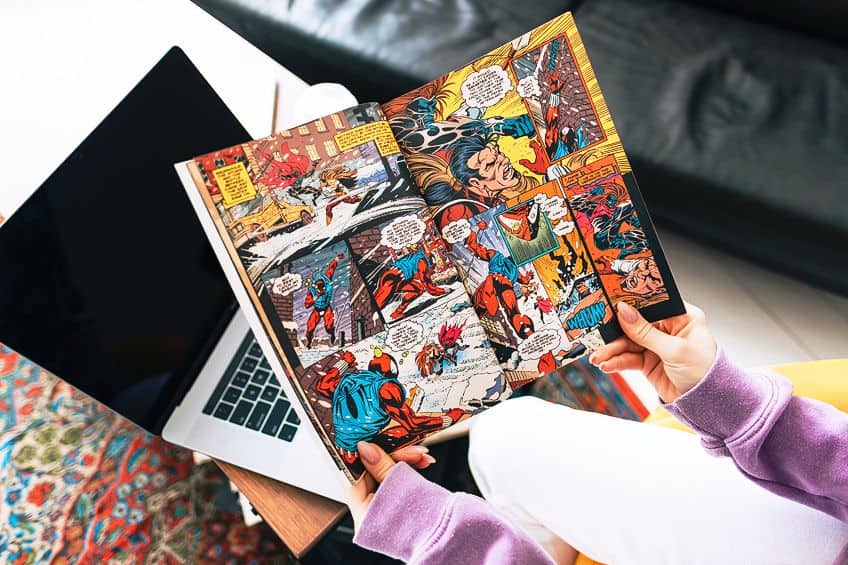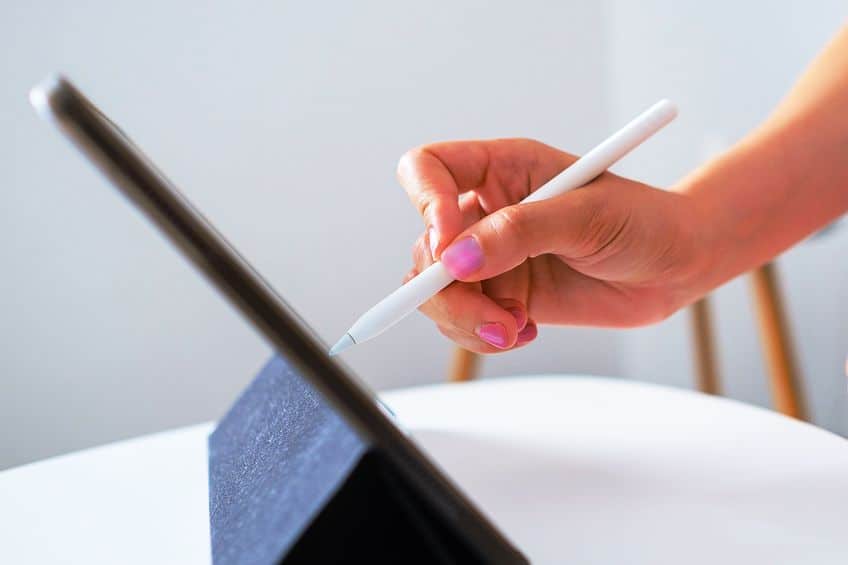Painting vs. Drawing – Know the Basics of Painting and Drawing
When it comes to the most fundamental and widely practiced forms of visual art, painting and drawing sit at the very top. Although these two art forms appear to be quite similar, there are several key differences between the mediums that set them apart from each other. If you are interested in understanding these differences beyond a surface-level perspective, you have found yourself in the right place. Join us as we discuss the difference between painting and drawing.
Painting vs. Drawing
Painting and drawing are the most common forms of visual art practiced by artists worldwide, and the two are often used side by side to produce artwork. Many of the techniques used when working with either medium are also interchangeable and can be applied to the other. Many basic principles of art theory also apply to both mediums. However, there is more than enough of a difference to set the two apart.
What Is Drawing?
While both mediums form the basis of the visual arts, drawing is more so concerned with the creation of two-dimensional images using shapes, lines, and tones. The medium typically involves the use of ink, pencils, or charcoal, with other illustration tools such as markers and pastels seeing frequent use as well. Unlike painting, drawing can often be used as a preparatory medium during the creation of more complex bodies of art, such as through sketches and studies.
It can nevertheless also be used to produce finished pieces, such as the works we commonly see in cartoons, comic books, and illustrations.
What Is Painting?
On the other hand, painting has a much broader definition that refers to a wide variety of media and techniques employed to produce images. Not unlike drawing, painting involves the creation of two-dimensional images, but the means through which to do so includes the use of pigments and binding mediums such as acrylic polymer, oil, gouache, and watercolor.
Through the use of different techniques and styles, painting can be used to produce a great degree of effects, ranging from the abstract and expressing to the detailed and realistic.
Key Differences
Let us now discuss some of the primary points of differentiating between the mediums of painting and drawing. Although bearing many similarities, the two have just as many opposing aspects. Here are some of the more noteworthy differences.
Materials
Of course, the primary difference between drawing and painting pertains to the materials used in their production. In drawing, the materials used are referred to as dry media. This would include charcoal, pastels, pens, and pencils, all of which are applied directly to the surface of whatever suffices as the canvas. Painting, however, involves the use of wet media, which, as the name would suggest, involves applying pigments mixed with liquid oils, acrylics, and other binders that are mixed with vehicles such as linseed oil or water that do not dry instantly after application.
Paint, unlike drawings, is also typically applied to the surface in layers.
Approach
Another key difference that separates painting from drawing lies in the approach. As aforementioned, drawing can be used as a preliminary step toward the creation of art, even for paintings. Unlike painting, it is more pragmatic for artists to produce studies and sketches using drawing techniques to figure out perspective and compositions among other details before beginning to work on the final piece.
The approach to painting, however, is more direct.
Once an artist has a general concept or idea of what they wish to paint, they will apply the paint directly to the canvas and methodically build upon the layers of color and texture until the final piece has been produced. Unlike drawing, paintings require more patience as artists will have to allow for initial layers to dry before the next can be applied. Painting also involves a lot of mixing to produce desired colors whereas drawing does not.
Techniques
There are also many significant differences between painting and drawing when it comes to the techniques used for either medium. Painting typically involves the layering of colors and the implementation of techniques such as impasto, glazing, and blending to produce the desired depth and texture. Drawing, on the other hand, involves the production of shapes and lines to define the form of subjects within the artwork. Compared to drawing, we can even say that painting offers a wider range of effects.
Unlike drawing, painting can involve the blending of colors and the addition of texture through the choice of paint and brushstrokes.
Styles
Lastly, the genres and styles associated with drawing and painting can differ as well. Precision and accuracy are two factors that often define drawings, especially in the cases of illustration and technical drawing. Drawings can also serve a utilitarian, informative, or instructional purpose far better than paintings. Paintings, however, involve styles that are far more often defined by the emotional and expressive qualities of fine art. None of these distinctions, however, can be considered absolute.
Many artists around the world will make use of both drawing and painting to exploit the strength of either medium and ultimately create works of art that are innovative and unique.
Styles of Painting
Now that we have covered the core difference between drawing and painting, we can now explore the styles of either in greater depth. The two art forms each have a plethora of amazing styles and genres, ranging from traditional to contemporary. Let us begin with painting. Painting is a diverse art form that has been in a constant state of evolution through the centuries, with various styles emerging from different phases and art movements. Each style has its own unique characteristics, influences, and techniques that distinguish them from one another. In this section, we will explore some of the different styles of painting.
Realism
This is a painting style whose origins date back to the 1840s when artists at the time sought to create objective and accurate depictions of the world. In this style of art, an emphasis is placed on detail and precision in the rendering of subjects. On the topic of subjects, the choices thereof for realism paintings were often extracted from the day-to-day and seemingly mundane. The idea was to capture the genuine essence of the subjects. The themes expressed in these artworks tend to reflect truthfulness and honesty, without embellishment.
Notable realism painters include Gustav Courbet, William-Adolphe Bouguereau, and Jean-Francois Millet.
Painterly
In stark contrast to realism, painterly is a style that also emerged from the 19th century but with an emphasis on the physicality and the act of painting itself. As artists veered further from realism, this painting style became increasingly popular, with its work being characterized by expressive and loose brushstrokes. In painterly art, the brushwork remains visible and forms a key part of the artwork itself. The colors and textures of the paint are an important focal point in this painting style. John Singer Sargent, James McNeill Whistler, and Édouard Manet are all popular examples of painterly artists.
Expressionism and Fauvism
Fauvism and Expressionism started in 1905 and 1912, respectively. These art styles are characterized by their focus on subjectivity and emotion. Expressionist paintings employ the use of intense and bold colors, with the subjects often depicted in distorted forms. The idea behind the style is to express the interior mechanisms of the painter through their depictions of physical subjects.
Famous Expressionist painters include Vincent van Gogh, Edvard Munch, and Egon Schiele.
Fauvism is very similar to expressionism and involves the aggressive application of bright colors in simplified forms. For many, the purpose of Fauvism was to buck the drab realistic conventions of impressionism and to reflect the energy and joy of life. Some of the most notable Fauvist painters include Henri Matisse, André Derain, and Maurice de Vlaminck.
Impressionism
Impressionism is a painting style that took off in 1960 when artists began to explore the impressions of light and color. In an impressionist painting, the focus is more on capturing the mood and atmosphere of scenes as opposed to their details. Loose and visible brushstrokes for key components of the aesthetics associated with impressionism. A popular technique applied by impressionists is to work en plein (outdoors) in order to capture the changing of light and color that occurs in nature.
Claude Monet, Pierre-Auguste Renoir, and Edgar Degas are three notable names in the field of impressionism.
Photorealism or Hyperrealism
Although often described as the most difficult style of painting, perhaps a better definition for photorealism is that of the most technically brilliant style of painting. Emerging in the late 1960s, photorealism and hyperrealism involves the creation of paintings that resemble subjects in painstakingly realistic detail. The true beauty in photorealism and hyperrealism lies in how artists are able to blur the lines between reality and the depictions thereof. Artists who employ these styles of painting typically work from photographs, which they then replicate using paint in explicit detail. In the case of hyperrealism, paintings would look almost if not entirely indistinguishable from the subjects they depict.
Abstraction
This is an art style that emerged in the early 20th century. Its primary focus lies in the depiction of non-representational forms and colors, and it often employs the use of geometric shapes. It is an art style developed as a breakaway from conventional painted art traditions. Some of the more notable Abstract painters include Kazimir Malevich, Wassily Kandinsky, and Piet Mondrian.
Abstract
Although it is the subject of much debate among art historians, abstract art is believed to have begun in 1910. It is also a style of painting that focuses on non-representational colors and forms. Abstract art tends to emphasize the process of creation more so than anything else. Unlike most traditional forms of painting, abstract art encourages improvisation and spontaneity. A good abstract artist will be able to respond intuitively to the materials they use and the act of painting itself.
Some of the most notable and renowned Abstract painters include the likes of Jackson Pollock, Mark Rothko, and Willem de Kooning.
Styles of Drawing
The styles found in the art of drawing are just as numerous and multifarious as their painting counterparts. If you have any interest in learning what these are, stick around for more information. Let us discuss some of the most common styles of drawing.
Illustration
Illustration is a very broad description, but it can most simply be defined as a style of drawing used to produce a visual representation of a story, idea, or concept. You will find this style of drawing most commonly used in advertising, comic books, and children’s picture books. Illustration is traditionally performed using graphite pencils, pens, and ink. Today, however, digital media is another tool that can be used to produce illustrations.
Life Drawing
This is a theoretical style of drawing that involves producing a drawing while using a live model as a reference. The most typical use of this drawing style is for the study of human proportions and anatomy. Pens, graphite pencils, charcoal, and pastels are among the multitude of mediums that can be used when producing life drawings.
Emotive Drawing
As the name would suggest, emotive drawing is a drying style whose primary purpose is to convey the thoughts, feelings, and emotions of the artist. It is a drawing style favored by creatives seeking a means to detail and express their personal emotions and experiences through the vehicle of art. Much like the drawing styles discussed above, emotive art can be produced using all sorts of media, including pens, pencils, digital drawing tools, and so forth.
Analytic Drawing
This style of drawing is more utilitarian in its purpose, which is to represent subjects and objects in an accurate and informative depiction. Technical drawings and scientific illustrations are two common examples of analytic drawings. Of course, a high level of precision and attention to detail is required in order to produce analytical drawings.
For this reason, modern analytic drawings are typically produced using digital drawing tools.
Architectural Drawing
This style of drawing is most typically used as a means to produce designs and plans for the construction of buildings and other structures. Unlike most other styles of drawing, architectural drawing does not allow for many licenses in terms of creative freedom. A high level of technical skill is required alongside a proficient understanding of construction techniques and building materials.
To produce reliable architectural drawings, years of theoretical study are required.
Perspective Drawing
Also used quite often in architectural and landscape drawing, perspective drawing is a technical style implemented to give the appearance of depth and space within the confines of a two-dimensional space. In order to produce accurate perspective drawings, one is required to have a proficient degree of understanding regarding horizon lines and vanishing points.
Diagrammatic Drawing
This is another utilitarian drawing style and it is implemented in the production of charts and diagrams that serve as a visual representation of complex information and data. You will also find this style of drawing being implemented in the creation of technical and scientific illustrations. To understand the subject matter that you intend on depicting in a diagrammatic drawing, you will require a high degree of understanding and skill.
Geometric Drawing
This is another type of technical drawing, which is often used in the field of engineering to provide a visual representation of a process or design. Geometric drawings involve the use of accurate and precise geometric patterns and shapes. In order to produce these types of drawings, one must have a firm understanding of geometric principles.
One may use all sorts of drawing mediums to produce geometric drawings, though the most suitable option would be digital media considering the amount of accuracy required.
Digital Drawing
We have mentioned digital media quite frequently during our discussion of the various styles of drawings, so much so that we feel it deserves its own section. Essentially, digital drawing is a method of drawing through the use of digital tools and software. Over the last several years, the popularity of digital drawing has been steadily increasing as our technology improves and devices such as the Wacom tablet become more accessible. There is a wide variety of tools and programs used to perform digital drawings, which include, styluses, graphic design software, and tablets.
Painting vs. Drawing: Which Is Harder?
Artists and art enthusiasts alike love to pose the question of whether painting is harder than drawing, or vice versa. Despite decades of debate, however, the answer remains far from being straightforward. While it is true that painting and drawing are two separate art styles that require different skill sets, whether either is more difficult than the other boils down to the strengths and weaknesses of every individual artist. Looking at drawing, we can deduce that it is commonly perceived as the foundation upon which all the visual arts are built. Put simply, it involves the use of lines and shading to produce images on a two-dimensional plane.
Drawings require focus, patience, and a fair degree of attention to detail. The pressure and direction of their strokes are something that an artist must pay close attention to while drawing.
The choice of material they work on will also influence the outcome of their drawings. Accuracy is an important component of drawing since it is much harder to conceal mistakes than it is for painters. Thus, skill and precision are often paramount in drawing. In the opposite corner, we see that painting involves the use of paint and color to produce a visual representation of an object or scene. In order to paint well, one must first develop an understanding of composition, color theory, and various painting techniques such as blending, paint mixing, and layering. It is a general consensus that painting allows for a greater degree of creative license and there are more techniques that one could use to produce unique effects.
Mistakes are also easier to conceal since you could simply apply more paint over them. At the end of the day, however, whether either is the harder form of art will entirely depend on the artist. Natural talent can often be a firm decider of which is easier for people. Some people just find it easier to paint than to draw, and vice versa. Regardless, both types of art will demand patience, dedication, and practice to ultimately master. Art is, at the end of the day, a matter of subjectivity and this applies not only to its perception but its creation as well. The real goal is to find the kind of art that speaks to you the most and to practice it until you have achieved the results you desire.
To conclude, we can deduce that painting and drawing, while sharing some similarities, have numerous significant differences that separate them from one another. The primary difference between paint vs. draw lies in the fact that the former uses wet media such as acrylic, watercolor, and oil, whereas the latter involves the use of dry media implements such as pencils, ink, and charcoal. Drawing can often be used as a preliminary step in the production of artwork, while paint mediums involve a more immediate approach. Drawings are defined by the use of shapes and lines, whereas paintings are created through the layering of colors and the utilization of various techniques to produce depth and texture. We hope that you have found this article informative, and that it has disambiguated the difference between drawing and painting for you!
Frequently Asked Questions
Is Painting Harder than Drawing?
When pinning paint vs. draw, the answer to which is harder is not that straightforward, since some people find one medium easier than the other. Both mediums require their own principles, tools, and theory to master, should one wish to become proficient in their production.
What Is the Hardest Style of Drawing?
This can be a matter of subjective opinion, but the fairest answer would be to say that hyperrealism is the most difficult style of drawing to master. This is because hyperrealism is meant to depict a live subject or scene with enough accuracy that the art is indistinguishable from what it depicts.
Megan is a writer and researcher who holds a degree in Social Sciences, with a specialization in Psychology and Environmental Science, from the University of Cape Town. Her dedication to acquiring knowledge and making a positive impact has driven her current work in promoting conscious and sustainable growth in Southern Africa. Megan’s interests encompass exploring the physical and psychological impacts of color in our environment on our mood and well-being. She is also passionate about the role of art and creativity, which has been an integral part of society since the beginning of human history. Since 2022, Megan has been contributing blog posts on painting and color theory at artfilemagazine.
Learn more about Megan van Schoor and about us.
Cite this Article
Megan, van Schoor, “Painting vs. Drawing – Know the Basics of Painting and Drawing.” artfilemagazine – Your Online Art Source. June 5, 2023. URL: https://artfilemagazine.com/painting-vs-drawing/
van Schoor, M. (2023, 5 June). Painting vs. Drawing – Know the Basics of Painting and Drawing. artfilemagazine – Your Online Art Source. https://artfilemagazine.com/painting-vs-drawing/
van Schoor, Megan. “Painting vs. Drawing – Know the Basics of Painting and Drawing.” artfilemagazine – Your Online Art Source, June 5, 2023. https://artfilemagazine.com/painting-vs-drawing/.



